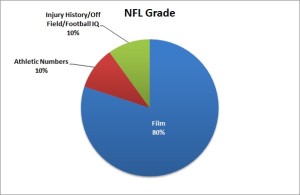
By Justin VanFulpen
With the 2017 NFL Draft less than a month away here is the average amount of players drafted at each position over the past 5 years (2011-2016) and the highs and lows.
QB – Average amount drafted – 11.6 – High amount drafted 15 (2016) Low amount drafted 7 (2015)
RB– Average amount drafted – 20.2 – High amount drafted 23 (2013) Low amount drafted 19 (2014,2012)
FB – Average amount drafted – 2.6 – High amount drafted 3 (2016,2015, 2013) Low amount drafted 2 (2014, 2012)
WR – Average amount drafted – 32.4 – High amount drafted 34 (2014,2015) Low amount drafted 28 (2013)
TE – Average amount drafted – 12.8 – High amount drafted 18 (2015) Low amount drafted 9 (2016)
OT – Average amount drafted – 20.8 – High amount drafted 26 (2015) Low amount drafted 18 (2013)
OG – Average amount drafted – 16.4 – High amount drafted 21 (2012) Low amount drafted 14 (2014)
C – Average amount drafted – 6.4 – High amount drafted 10 (2014) Low amount drafted 4 (2012)
DE – Average amount drafted – 22.6 – High amount drafted 30 (2013) Low amount drafted 21 (2012)
DT – Average amount drafted – 20.4 – High amount drafted 23 (2012) Low amount drafted 18 (2015)
LB – Average amount drafted – 33.4 – High amount drafted 37 (2015) Low amount drafted 27 (2013)
CB – Average amount drafted – 31.4 – High amount drafted 32 (2016,2015) Low amount drafted 29 (2013)
S – Average amount drafted – 19.4 – High amount drafted 23 (2013) Low amount drafted 15 (2015)
K – Average amount drafted – 1.8 – High amount drafted 4 (2012) Low amount drafted 0 (2015)
P – Average amount drafted – 1.8 – High amount drafted 3 (2016) Low amount drafted 1 (2015,2014)



 By Justin VanFulpen
By Justin VanFulpen




